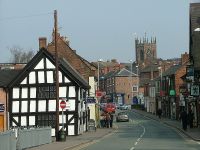Nantwich (/ˈnantwɪtʃ/ NAN-twitch) is a market town and civil parish in Cheshire, England. It has among the highest concentrations of listed buildings in England, with notably good examples of Tudor and Georgian architecture. It had a population of 17,424 in 2011.
History
The origins of the settlement date to Roman times, when salt from Nantwich was used by the Roman garrisons at Chester (Deva Victrix) and Stoke-on-Trent as a preservative and a condiment. Salt has been used in the production of Cheshire cheese and in the tanning industry, both products of the dairy industry based in the Cheshire Plain around the town. Nant comes from the Welsh for brook or stream. Wich and wych are names used to denote brine springs or wells. In 1194 there is a reference to the town as being called Nametwihc, which would indicate it was once the site of a pre-Roman Celtic nemeton or sacred grove.
In the Domesday Book, Nantwich is recorded as having eight salt houses. It had a castle and was the capital of a barony of the earls of Chester, and of one of the seven hundreds of medieval Cheshire. Nantwich is one of the few places in Cheshire to be marked on the Gough Map, which dates from 1355–66. It was first recorded as an urban area at the time of the Norman conquest, when the Normans burnt the town to the ground, leaving only one building standing.
The town is believed to have been a salt-producing centre from the 10th century or earlier. The Norman castle was built at the crossing of the Weaver before 1180, probably near where the Crown Inn now stands. Although nothing remains of the castle above ground, it affected the town's layout. During the medieval period, Nantwich was the most important salt town and probably the second most important settlement in the county after Chester. By the 14th century, it was holding a weekly cattle market at the end of what is now Beam Street, and it was also important for its tanning industry centred in Barker Street.
A fire in Decem
